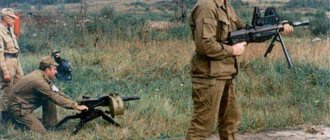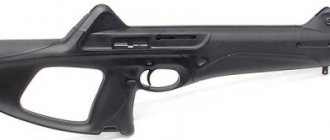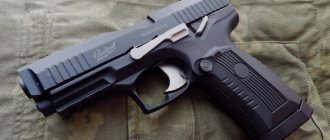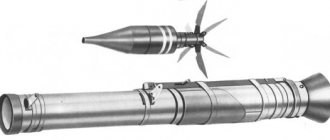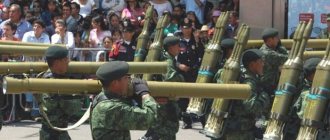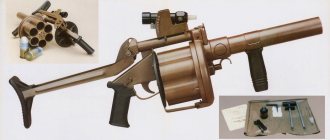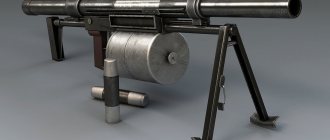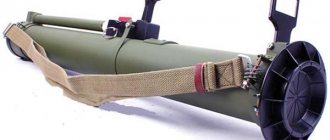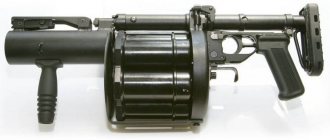The pursuit of rapid fire is eternal. But sometimes it leads to frightening results. Today we will tell you about perhaps the most elaborate product, created with the goal of throwing the maximum amount of metal towards the enemy in the minimum time. Meet Metal Storm.
The pursuit of rapid fire is eternal. But sometimes it leads to frightening results. Today we will tell you about perhaps the most elaborate product, created with the goal of throwing the maximum amount of metal towards the enemy in the minimum time. Meet Metal Storm.
Once upon a time there lived in faraway Australia a manager named James Michael O'Dwyer. He lived for himself, had a trading business, came up with useful things, like air-inflated sneakers. But his passion for invention outweighed him, and James decided to devote himself entirely to his favorite business. And he swung at the thing, which journalists would later dub “the most deadly weapon in the world.”
The most famous machine gun: Maxim machine gun
Country: Great Britain (modification - Russia)
Developed: 1883 (modification - 1910)
Weight: 64.3 kg (44.23 - machine with shield)
Rate of fire: 600 rds/min
Initial bullet speed: 740 m/s
It is difficult to say that the Maxim is included in the list of the best small arms over the past 100 years, because the Anglo-American inventor Hiram Maxim received the first patents for individual elements of the new weapon in the summer of 1883, and in October 1884 he demonstrated the first working model. But one of the most famous varieties of Maxim appeared in 1910, which allows it to “fit” into the century.
The principle of operation of the Maxim is simple and is based on the use of barrel recoil. Powder gases from the shot throw the barrel back and activate the reloading mechanism: the cartridge is removed from the belt and goes into the breech, while the bolt is cocked. The canvas belt held 450 rounds of ammunition, and the machine gun's rate of fire reached 600 rounds per minute. True, the powerful weapon was not flawless. Firstly, the barrel overheated greatly and required constant changes of water in the cooling casing. Another drawback was the complexity of the mechanism: the machine gun jammed due to various problems with reloading.
In Russia, production of the machine gun began in 1904 at the Tula plant. The most famous Russian modification of the Maxim was the 7.62 mm heavy machine gun of the 1910 model (the original caliber of the machine gun was 303 British or 7.69 mm in the metric system). In the same year, the designer, Colonel Alexander Sokolov, designed a wheeled machine gun for a machine gun - it was this machine that gave the weapon a classic look. The machine greatly simplified the issues of marching and moving a heavy machine gun from position to position.
Fastest-firing production weapon: M134 Minigun
Country: USA
Designed: 1962
Weight: 24−30 kg (machine gun body with electric motor and power mechanism)
Length: 801 mm
Caliber: 7.62 mm (0.308)
Rate of fire: from 300 to 6000 rounds/min (effective -
3000−4000)
Initial bullet speed: 869 m/s
Of course, prototypes can be much faster-firing, but among production weapons, the aircraft machine guns of the M134 Minigun series are considered to be among the record holders for this indicator. These 7.62 mm six-barreled machine guns operate in a Gatling design and are capable of firing up to 6,000 rounds per minute. A new cartridge is fed into the upper (cooled) barrel, and the shot is fired from below. The rotation of the barrels is provided by an electric drive. The M134 received its baptism of fire in the Vietnam War. By the way, contrary to misconceptions, in “Predator” and “Terminator” it is not this machine gun that is used, but its younger brother, the XM214 Microgun, which did not go into production.
Mauser C96
Gigabit Ethernet
When developing Gbit Ethernet, a very important question arose - the transmission time of one bit was already 1 ns and it took only 0.512 μs to transmit one piece of data. Even when calculating head-on with my formula without taking into account delays, the length is 50 meters (and 20 meters taking these values into account). Very little, and therefore it was decided, instead of reducing the distance (as was the case with the Ethernet->Fast Ethernet transition), to increase the minimum data size to 512 bytes - 4096 bits. The transmission time for such a portion of data remained approximately the same - 4 seconds versus 5. There is, of course, another point. that it is not always possible to reach such a size - 4 kB of data, so at the end of the frame, after the FCS field, the missing amount of data is added.
Considering that we abandoned the common bus a long time ago, we have a separate environment for receiving and transmitting, and there are no collisions as such, all this looks like crutches. Therefore, in the 10 Gbit Ethernet standard, the CSMA/CD mechanism was abandoned altogether.
Fastest firing weapon: Metal Storm MK5
Number of barrels: 36
Estimated rate of fire: 1,080,000 rounds/min
Theoretical maximum rate of fire: 1,620,000 rounds/min
The ultra-high-speed weapon of the Australian company Metal Storm Limited is unlikely to ever go into mass production, but it cannot be ignored. The company's founder, James Michael O'Dwyer, invented and patented a rapid fire system, the theoretical rate of fire of which reaches 1,000,000 rounds/min. The Metal Storm machine gun has no moving mechanical parts, each barrel simultaneously holds several cartridges, and shots are fired via an electronic pulse. The critical problem that the developers faced was the impossibility of supplying such a number of cartridges in a timely manner. Therefore, the rate of fire shown in tests is calculated, and the functionality of the “iron storm” is nullified when used in real combat. However, the company is developing in various directions and is using Metal Storm technologies in weapons that have a more realistic chance of being included in the series.
A Million Rounds Per Minute - Metal Storm
Page 1 of 2
Australian Mike O'Dwyer made his first claim to world fame by inventing a device for on-the-go ventilation in athletic shoes. But in the 1990s, he began working on inventions far more terrifying than even the smelliest shoes: a naval defense weapons system theoretically capable of firing millions of shots at an incoming missile. He developed a unique concept for a firearm that is capable of achieving incredibly high rates of fire, but has no moving parts. To paraphrase his assistant, O'Dwyer's weapon system could be described as a combination of a multiple rocket launcher and a Roman candle. in Brisbane was officially registered in 1993, but uses his developments in weapons based on the idea of a “wall of fire” over the previous nine years.
, Metal Storm
firearms are a single barrel loaded with a bunch of ammunition that contains about 15 rounds of ammunition.
Each projectile in the bundle is equipped with a propellant charge and is fired in turn using an electrical ignition circuit. Because the system has no interacting moving parts and no shell casings that must be ejected, ammunition can be fired in a virtually continuous stream. In this case, the rate of fire is determined only by the time required to reduce the pressure in the barrel to a safe level after the previous shot. Theoretically, the rate of fire of such weapons can reach 45,000 rounds per minute per barrel, provided that loading is uninterrupted. As has already been demonstrated with the AM-180 .22LR (5.56 mm) submachine gun, continuous fire at a very high rate can cause damage to a target completely disproportionate to the caliber of the weapon or the weight of the bullet. Metal Storm also emphasizes the potential of its weapon systems to cause structural damage when fired at a rate of "only" 45,000 rounds per minute.
After spending approximately 15,000 hours and approximately $2 million in research and development, Metal Storm had seven operational prototype weapons based on the new principle at its disposal. During testing, thousands of shots were fired from them. It was possible to achieve an extrapolated rate of fire of about 135,000 rounds/min. If you combine the barrels, you can get quite a lot of firepower. The three-barrel weapon system showed a rate of fire of a maximum of 135,000 rounds/min. Metal Storm specialists obtained this figure in bench tests, firing a burst of 45 shots. Until now, tests have used shot sets with a 9mm bullet weighing 140 grains, loaded in accordance with the standard of the Institute of Sporting Arms and Ammunition Manufacturers.
Metal Storm
's Mk.5 small arms prototype is a compact 36-barrel launch container loaded with 540 rounds. Tested at a rate of 60,000 rounds per minute, this model is theoretically capable of firing at a mind-blowing rate of 1,620,000 rounds per minute - which is what O'Dwyer intends to achieve. Mk.5 combines 12 three-barrel subsystems, each barrel of which is loaded with 45 ammunition. And this subsystem has already shown a rate of fire of 135,000 rounds/min. Additionally, significant design changes are being made to the prototype to improve safety. For simplicity, all tests were performed using smooth barrels. It is believed that the transition to rifled barrels will not create any serious difficulties, but an alternative may be the use of feathered bullets. Surprisingly, O'Dwyer states that during a test hand-fire test at 25 m, the Mk.5 smooth-bore weapon system showed only 0.79 inch (about 20 mm) of group mean point of impact deviation. In prototype small arms, each bullet is inserted into the barrel by hand, separated from the next by a 0.14 inch (3.56 mm) diameter steel spacer, and then filled with compound to form a bond at the rear of the barrel. To equip each projectile with a propellant charge of conventional Australian BM2 cartridge powder weighing about 5 grains, there are ports at the top of the rear part of the barrel according to the number of projectiles, into which gunpowder is poured, and then an Olin M52 electric detonator cap is inserted.
Going forward, the designer intends to connect the bullet to the propellant, rather than pouring the propellant through ports. If the charge is solid, then perhaps it will replace the gaskets currently used. O'Dwyer also envisions the possibility of using an internal detonator cap and even a laser ignition system at the final stages of development.
Using an electric ignition circuit, you can fire at the desired rate from one or more barrels, alternately or simultaneously. The prototype weapons used an external Brisbon computer-controlled electronic relay. Industrial designs, however, are expected to use miniaturized embedded electronic systems. The weapon's status will be indicated on the LCD screen. When a propellant charge is ignited, a relatively soft bullet expands under the pressure of powder gases and hermetically seals the barrel, and the compression of unfired bullets prevents the gases and flame from breaking back.
Special measurements during bench tests of weapons showed that the temperature of one barrel after firing a burst of 15 shots at a rate of 45,000 rounds per minute increases by only 3.5 ° C. Each propellant charge burns in a new place, which significantly reduces the risk of barrel overheating. The position of each bullet in the bunch relative to the bore affects its external ballistics: for example, the very last bullet passes through the longest bore. Because of this, given the same propellant charges for each ammunition, variations in the initial flight speed of bullets located at different points in the bundle are inevitable. This circumstance also affects the energy of the bullet at the moment of impact with the obstacle and the spread of bullets at the target. In addition, the time it takes for the pressure in the bore to drop to a safe level after firing will be different for each ammunition.
However, O'Dwyer postulates the possibility of preloading the barrel with ammunition manufactured to accommodate different positions in the bunch, thereby eliminating the above variations. On the other hand, you can use these variations in order to get bullet separation at the target. It is possible to change the configuration of the spacers to turn them into cores that use kinetic energy, possibly feathered, and then the bullet will be replaced by a sabot. An alternative option is to install a gasket in the nose rather than the tail of each bullet - the result will be the same.
With the assistance of the Australian Trade Commission in Atlanta, Georgia. USA, in 1995, O'Dwyer began negotiations with three major American weapons companies to license him new technology to further develop weapons systems. According to him, he expects to conclude a deal with one of the companies, and in addition, he has received encouraging news from Europe.
Metal Storm is vigorously trying to apply its concepts to a wide variety of military systems. While a seven-digit rate of fire is a good market attraction, it is not particularly significant in and of itself and certainly does not define a weapon system. Any weapon that fires continuously at this rate will soon be out of ammunition. Replenishing ammunition will pose considerable difficulties for the logistics supply system.
Despite the fact that the company has achieved undeniable success in the production of demonstration weapons, the production of samples suitable for adoption is still a long way off. Moreover, some of the company's proposed multiple launch rocket systems are simply impractical. They would demand the abandonment of traditional weapons in the hope of obtaining benefits that in reality may not be useful to anyone and even create new technical problems, for example, in terms of recoil damping - and not just the systems of larger capybras.
However, some of Metal Storm's ideas are worth serious consideration. One area where the wall of fire approach seems particularly attractive is close-in air defense of ships. Shipborne short-range air defense systems are the last hope to destroy incoming anti-ship missiles like the two Iraqi-launched Exocet missiles that severely damaged the USS Stark in 1987 (its short-range air defense system was turned off at the time).
<< First < Previous 1 Next > Last >>
Marketing Hamburger
James O'Dwyer got bored and in 2005 sold his stake in the company for a measly half a million dollars - despite the fact that it was valued at as much as 43 million. But for some reason there were no buyers for this price.
How many arms exhibitions around the world have “Storm Rapid Fire” not been to, how much money was spent on advertising! The scheme was fine-tuned: marketers drove potential client representatives into a corner and cajoled them with stories about the rate of fire, reduced recoil and other bonuses. The military, supplied with instructions from their superiors, refused to be seduced.
But in 2010, company representatives nevertheless caught some “jacket”, who accidentally turned out to be the Minister of Correctional Services of Papua New Guinea. He managed to secure an order for 500 MAUL (Multi-shot Accessory Under-barrel Launcher) installations and 10,000 five-shot barrels (though with non-lethal ammunition) for a total amount of $3,365,000. So now New Guinea prisons are equipped with the latest technology. In theory.
Moreover, in the same 2010, the Australian army, having seen enough of the Americans, decided to organize a competition for its own weapon of the 21st century called AICW (Advanced Infantry Combat Weapon, “Advanced Infantry Combat Weapon”). The Austrian Steyr AUG was used as a base, a three-round grenade launcher was attached to the top, and a cunning sight with a ballistic computer was placed on the third floor.
Alas, the grenade launcher had a drawback typical of MS weapons: the barrel was loaded only by the manufacturer. And in general, such a multi-story hamburger of weapons technology turned out to be too big for the Australian mouth. After a couple of years, the AICW program died out, and with it went the last hope of adopting the system into service. In 2012, Metal Storm declared bankruptcy.
Army and weapons
Mike O Dwyer from Australia developed the “ super-fast shooter”
", producing 1 million. shots per minute.
Similar rate of fire
was achieved by increasing the number of barrels and the rate
of shots
of each of them.
Moreover, the design has no moving parts except the trigger. The launch system is based on electronics, each barrel contains several ammunition
, and they are initiated by electric current.
The researcher conducted experiments with the number of barrels 20, 30, 60, and thereby increased the rate of fire
.
But, obviously, making a pistol
or
machine gun
with so many barrels is crazy.
The fastest-firing invention
A prototype pistol consisting of three barrels
Soon
VLe
pistol , firing 50 thousand
rounds
per minute.
Its single barrel
held 7 bullets, and the burst lasted only a fraction of a second.
In this case, there was no question of fast reloading. Three bullets fired from this VLe
almost at the same moment fly along almost the same trajectory.
Although the recoil, even in such a short time, slightly displaces the weapon
.
The spread is small. And it comes in handy here - the chance of hitting the target with the first “triple” shot
increases.
The firing system of this model is designed for several modes: one bullet, two, three, or all at once. Soon it became possible to reload a weapon
by inserting a straight clip into the barrel.
The experimenter is of the opinion that weapons
of this system, but with several
barrels,
should replace modern
pistols
.
The process of recharging the experimental installation "Metal Storm"
Mike O'Dwyer's developments are not limited to the creation of infantry weapons
, he proposes to use the “
Metal Storm
” system for “scrupulous” aerial bombardment, and is developing heavy, “company”, massive fire systems. In a salvo, for example, from 24 barrels of 30 or 40 mm caliber, each barrel fires 8-10 shells in hundredths of a second. The scientist's projects have received support from the US Army, and although there is no talk of procurement, the researcher receives significant funding.
To develop your business, expand the company’s production and experimental potential and improve the Metal Storm “storm”
acquired at the end of 2003 the American company ProCam, a manufacturer of precision mechanical parts for weapon systems and ammunition.
—————-
Discuss on the forum
——————
https://metalstorm.com/
Gigabit Ethernet
When developing Gbit Ethernet, a very important question arose - the transmission time of one bit was already 1 ns and it took only 0.512 μs to transmit one piece of data. Even when calculating head-on with my formula without taking into account delays, the length is 50 meters (and 20 meters taking these values into account). Very little, and therefore it was decided, instead of reducing the distance (as was the case with the Ethernet->Fast Ethernet transition), to increase the minimum data size to 512 bytes - 4096 bits. The transmission time for such a portion of data remained approximately the same - 4 seconds versus 5. There is, of course, another point. that it is not always possible to reach such a size - 4 kB of data, so at the end of the frame, after the FCS field, the missing amount of data is added.
Considering that we abandoned the common bus a long time ago, we have a separate environment for receiving and transmitting, and there are no collisions as such, all this looks like crutches. Therefore, in the 10 Gbit Ethernet standard, the CSMA/CD mechanism was abandoned altogether.
The most officer's pistol: Mauser C96
Weight without cartridges: 1.13 kg
Cartridge: 7.63 x 25 mm, 9 mm x 25 mm, etc.
Initial bullet speed: 425 m/s
Sighting range: 150−200 m without stock
The Mauser C96 evokes in us a strong association with a man in a leather jacket and the abbreviation Cheka. This model began to be produced in Germany in 1896; the pistol stood out for its excellent accuracy, high effective firing range, and “survivability”; Its main disadvantages were bulkiness and serious mass. What is surprising is that the Mauser was not officially in service with any army in the world (maximum - partial local use), while more than a million copies were produced, and officers from different countries preferred it as a personal weapon to all competitors.
The most multi-shot gas pistol: Reck Miami 92 F
Country: Germany
Weight without cartridges: 1.14 kg
Length: 215 mm
Caliber: 8, 9, 15 mm
Food: magazine for 11 (for the 9 mm version), 18, 20, 24, 28 rounds
RECK Miami 92F is a gas pistol manufactured by the German company Umarex, which is an exact copy of the classic Beretta 92 pistol. RECK gas pistols come in 8 and 9 mm calibers. The 9mm version has a completely ordinary magazine with a capacity of 11 rounds, but 8mm RECK Miami magazines can hold from 18 to 28 (!) rounds, depending on the modification. Apart from prototypes, oddities and a 40-round magazine for the Mauser, the RECK Miami 92F has no competitors in the field of multi-charging.
M134 Minigun
BioShock (series)
I love the way Jack's hand looks when he uses the Burn Plasmid. All the biological enhancements in Rapture are scary in their visceral ways—I never want to see that Insect Swarm video again—but there's something beautiful and problematic about walking through the empty hallways of BioShock, with your left arm burning up from the inside, which could be history for some half-baked fan theory.
In this Rand dystopia, fire is on the Left! I also think BioShock does probably the best job of letting us live out our deepest, truest arson fantasies. Just snap your fingers and set anything on fire. It's that simple. Great for taking out crazy people in a defeated kingdom or maybe for party tricks.
